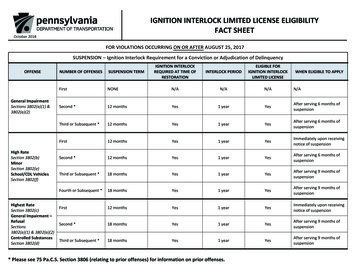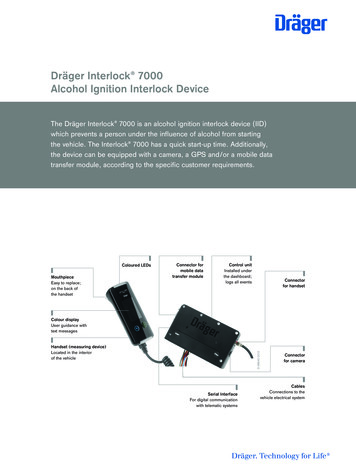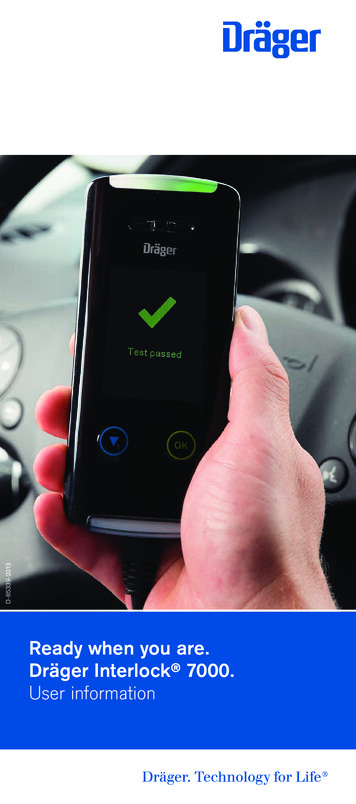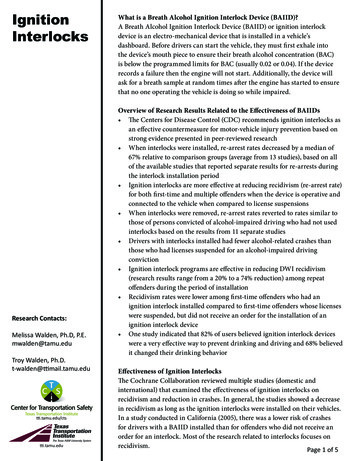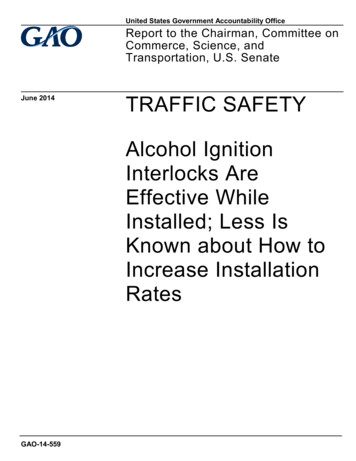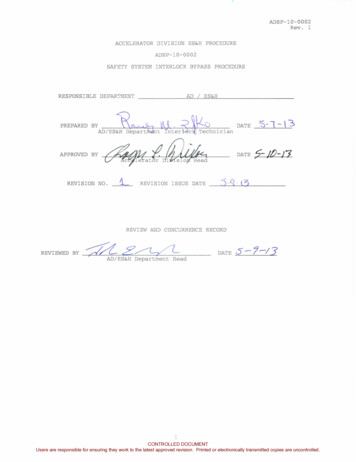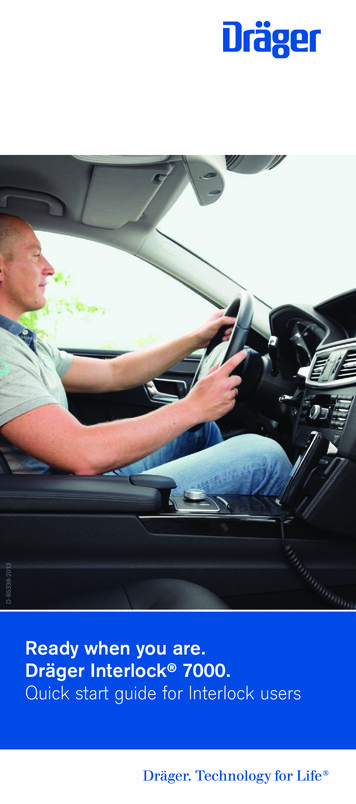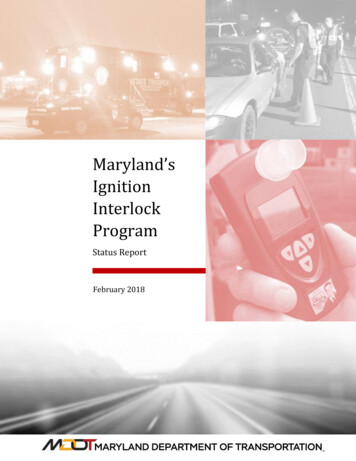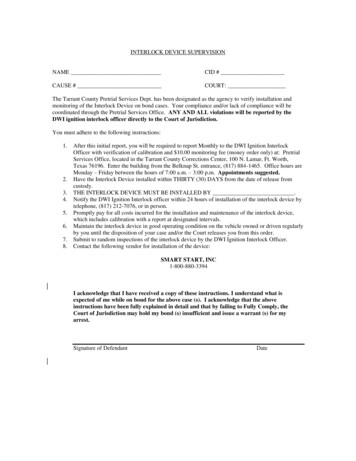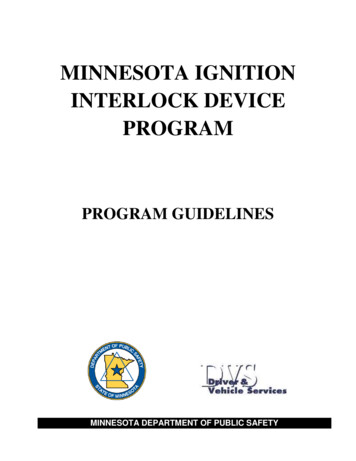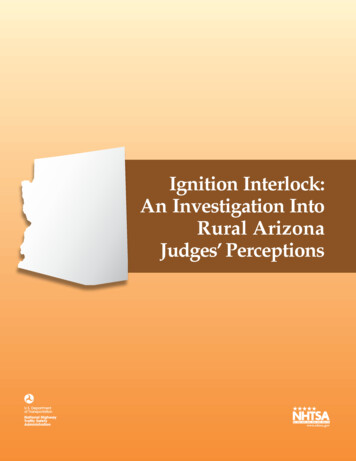
Transcription
Ignition Interlock:An Investigation IntoRural ArizonaJudges’ Perceptions
DISCLAIMERThis publication is distributed by the U.S. Department of Transportation, NationalHighway Traffic Safety Administration, in the interest of information exchange.The opinions, findings, and conclusions expressed in this publication are those ofthe authors and not necessarily those of the Department of Transportation or theNational Highway Traffic Safety Administration. The United States Governmentassumes no liability for its contents or use thereof. If trade or manufacturers’names or products are mentioned, it is because they are considered essential tothe object of the publication and should not be construed as an endorsement.The United States Government does not endorse products or manufacturers.
Technical Report Documentation Page1. Report No.2. Government Accession No.3. Recipient’s Catalog No.DOT HS 812 0254. Title and Subtitle5. Report DateMay 2014Ignition Interlock: An Investigation into Rural Arizona Judges’Perceptions6. Performing Organization Code7. Author(s)8. Performing Organization Report No.Fred Cheesman, Matthew Kleiman, Cynthia G. Lee, and Kathryn Holt9. Performing Organization Name and Address10. Work Unit No. (TRAIS)National Center for State Courts300 Newport AvenueWilliamsburg, VA 2318511. Contract or Grant No.12. Sponsoring Agency Name and Address13. Type of Report and Period CoveredU.S. Department of TransportationNational Highway Traffic Safety Administration (NHTSA)1200 New Jersey Avenue, SEWashington, DC 20590Final Report; September 12, 2008 –January 11, 2012DTNH22-08-F-0013014. Sponsoring Agency Code15. Supplementary NotesAlan Block was the NHTSA COTR16. AbstractThis study sought to answer several questions regarding 2007 Arizona legislation requiring ignition interlock for alloffenders convicted of Driving-Under-the-Influence (DUI), including first time DUI offenders. At the time the law waspassed, Arizona was only one of two States (New Mexico being the other) to require ignition interlock for first timeoffenders. Of particular focus in the study were the implications of the legislation for rural areas. The project staffobtained information from judges in rural Arizona jurisdictions that routinely hear DUI cases to obtain their impressions ofthe legislation. Several themes emerged from the interviews: Judges perceived ignition interlock as a practical and effective sanction for DUI offenders.Ignition interlock service providers were limited or non-existent in rural jurisdictions.DUI sanctions were costly and may have served as a barrier for offenders attempting to get their licensesreinstated.Repeat DUI offenders were often charged as first-time offenders in rural jurisdictions.Judges were aware of ignition interlock and current DUI laws, but were interested in additional training andinformation.The researchers also investigated charge reduction behavior for convicted DUI offenders, before and after implementationof the legislation in both urban and rural jurisdictions. They found a historically increasing trend for charge reductions thatwas driven by charge reductions for Extreme and Felony DUIs. The trend for less serious offenders was flat in both urbanand rural jurisdictions. The researchers concluded that judges have not modified their charge reduction behavior towardless serious offenders despite the logistical burdens that the legislation places on DUI offenders, especially those in ruraljurisdictions.17. Key Words18. Distribution StatementIgnition Interlock, DUI, DUI Offenders, JudgesDocument is available to the public from the National TechnicalInformation Service www.ntis.gov.19. Security Classif. (of this report)20. Security Classif. (of this page)21. No. of PagesUnclassifiedUnclassified41Form DOT F 1700.7 (8-72)Reproduction of completed page authorizedi22. Price
AcknowledgementsThe National Center for State Courts (NCSC) research team for this project would like toacknowledge the assistance of the following individuals without whose guidance, support, anddirect material aid this project could not have been completed and to thank them mostprofoundly: Arizona Governor’s Office of Highway Safety:o Alberto Gutier, Director Arizona Supreme Court, Administrative Office of the Courtso Jerry Landau, Government Affairs Directoro Paul Julien, Judicial Education Officero Humberto Cisneros, Research and Statistical Specialist National Highway Traffic Safety Administration (NHTSA)o Alan Block, Research Psychologist, Project Monitoro Cheryl Neverman, Senior Program Managero Brian Chodrow, Senior Program Managerii
Table of ContentsAcknowledgements . iiI. Introduction .1II. The Problem .3III. Arizona Ignition Interlock Statutes and Regulations .5IV. Judicial Education .13V. Rural Judges’ Perceptions.16VI. Analysis of Charge Reduction at Sentencing .24VII. Conclusions and Recommendations .27Appendices .31Appendix A: TIRF Curriculum Questions .31Appendix B: Arizona Judge Interview Questions.34iii
I.IntroductionThe purpose of the following study was to investigate the effect of 2007 Arizona (AZ)legislation requiring ignition interlock for all offenders convicted of Driving-Under-theInfluence (DUI), including first time DUI offenders. At the time, AZ was only one of two states(New Mexico being the other) to require ignition interlock for first time offenders. In particular,we sought to examine the effect of this legislation on rural jurisdictions.An alcohol ignition interlock requires a driver to pass a breath test for the presence of alcoholbefore the vehicle will start. Ignition interlocks simultaneously serve the goals of incapacitationand deterrence. As a means of incapacitation, interlocks are intended to promote public safety byphysically preventing convicted impaired drivers from re-offending. The threat of being forcedto install an interlock may also serve as a general deterrent discouraging the public at large fromdriving after consuming alcohol, as well as a specific deterrent reducing recidivism amongoffenders who have previously experienced the inconvenience of interlock use. 1In 2007, Arizona became the second state in the nation to require all first-time drunk drivingoffenders to equip their vehicles with ignition interlock devices. The first was Arizona’sneighbor New Mexico, which implemented a one-year interlock requirement for first-timeoffenders in 2005. 2 New Mexico saw a concurrent decline in alcohol-related traffic fatalities,although this trend began prior to 2005 and there is insufficient evidence to attribute it to the1See Robert B. Voas & Deborah A. Fisher, Court Procedures for Handling Intoxicated Drivers, 25 ALCOHOL RES.& HEALTH 32, 34 (2001). Voas and Fisher classify the interlock device as a specific deterrent designed to “beaversive and deter recidivism” by persons previously convicted of drunk driving. In Arizona, opponents of the 2007interlock legislation focused on the general deterrent effect, arguing that “the threat of breath-testing devices wouldkeep social drinkers from spendin es and include a third or subsequent DUIoffense within an 84-month period; a DUI offense committed on a restricted, suspended, orrevoked license, or while the offender is required to use an ignition interlock; or any DUI offensecommitted with a passenger under the age of fifteen in the vehicle. Tables 2 and 3 summarize thepenalties for the various categories of misdemeanor and felony DUI offenses under Arizona lawas of April 2010, respectively. Four separate levels of intoxication are distinguished underArizona law: “impaired to the slightest degree,” BACs of at least .08 (.04 for drivers of commercial vehicles) but less than .15 .15 to .20 .20 or higher.1412Editorial, Anti-DUI Mission Goes On, ARIZ. REPUBLIC, Feb. 2, 2008, at Opinions 4; Dick Foreman, Only TimeCan Judge Schapira’s New DUI Law, Ariz. Republic, Oct. 26, 2007, at Tempe Republic 31; Jessica Coomes,Legislators Send DUI Bill to Governor, ARIZ. REPUBLIC, May 16, 2007, at Valley & State 1; Letter from Gov. JanetNapolitano to Jim Weiers, Speaker, Ariz. H. Rep. (Apr. 29, 2008), available f.13See Appendix infra.14ARIZ. REV. STAT. ANN. §§ 28-1381 to -1383 (2010)6
Table 2: Arizona Sanctions for Misdemeanor Driving Under the Influence15Minimum BACSanction.08or Impaired to theSlightest Degree*.08or Impaired to theSlightest Degree,.20.152 nd in 84 months*.15(2 nd in 84 months.202 nd in 84 monthsJail 10consecutive days 90 days(30 consecutive) 30consecutive days 120 days(60 consecutive) 45consecutive days 180 days(90 consecutive)Judge may suspendjail for completingtreatmentall but 24 hoursall but 30 daysN/AN/AN/AN/ALicense revocationN/A1 yearN/A 1 yearN/A 1 yearIgnition interlock 12 months 12 months 12 months 12 months18 months24 monthsFine 250 500 250 500 500 1,000Other assessments 1,000 2,500 2,250 2,750 2,250 2,750court may order 30 hourscourt may order 30 hourscourt may order 30 hoursCommunityrestitutionSources: Ariz. Rev. Stat. Ann. §§ 28-1381, 28-1382, 28-3319 (2008).*.04 for commercial vehicles.15N/A means “not applicable.”7
Table 3: Arizona Sanctions for Felony (Aggravated) Driving Under the InfluenceCircumstancesSanctionPresumptive prisonsentence**No suspension orrelease beforeTreatmentRevocation of licenseIgnition interlockDUI While LicenseRestricted,Suspended,or Revoked3 rd orSubsequent DUIin 84 monthsBAC .08or Impaired toSlightest Degreewith Passenger 15 Years*2.5 years2.5 years1 year1 year1 year2.5 years24 hours30 daysN/AN/ABAC .15with Passenger 15 YearsRefusal of LawEnforcementDUI WhileBAC Test WhileInterlock Required Interlock Required4 months (3 rd DUI)4 months8 months (4 th orsubsequent DUI)yesyesyesyesyesyes3 years3 years3 years3 years3 years3 years 24 months 24 months 24 months 24 months 24 months 24 monthsFine 750 750 750 750 750 750Other assessments 3,250 3,250 3,250 3,250 3,250 3,250Forfeiture of vehicleyesyesyesyesyesyesSources: Ariz. Rev. Stat. Ann. §§ 28-1383, 28-1384, 28-3319 (2008); Ariz. Sup. Ct., 2008 Criminal CodeSentencing Provisions (2009).*BAC .04 for commercial vehicles.**See 2008 Criminal Code Sentencing Provisions for details regarding felony prison sentences.No minimum BAC is required in order to convict a defendant of driving while impaired tothe slightest degree. A BAC of at least .08 creates a presumption of intoxication, a BAC greaterthan .05 but less than .08 creates no presumption regarding intoxication, and a BAC of .05 or lesscreates a presumption that the driver was not intoxicated. 16 These presumptions may be rebuttedby other evidence, meaning that it is possible for a driver with a BAC of less than .05 to beconvicted of driving while impaired to the slightest degree if other evidence shows that the driverwas intoxicated. 17 In practice, the presumptions are relevant only to the charge of driving whileimpaired to the slightest degree, because driving with a blood alcohol content of .08 or above isillegal per se, and no showing of impairment is required for conviction.1617ARIZ. REV. STAT. ANN. § 28-1381.G (2010).ARIZ. REV. STAT. ANN. § 28-1381.H (2010).8
Mandatory sanctions for all misdemeanor DUI offenses include jail time, fines and othermonetary assessments, and the use of an ignition interlock. Table 2 summarizes the sanctions formisdemeanor DUI offenses. Penalties for driving while impaired to the slightest degree areidentical to those for driving with a BAC of .08 or above; penalties increase for BACs at orabove .15 and .20. Within each BAC category, penalties for a second DUI offense within an 84month period are more severe than those for a first offense; second offenses also result incommunity service and revocation of the offender’s driver’s license. 18Table 3 shows the penalties for felony DUI offenses. All felony DUI offenses result inmandatory alcohol or drug treatment, fines and assessments, license revocation followed by aperiod of interlock usage, vehicle forfeiture, and prison time as prescribed by Arizona’s felonysentencing guidelines. 19When a person is arrested on suspicion of DUI and the results of a blood or breath alcoholtest indicate a BAC of .08 or higher (.04 for the driver of a commercial vehicle), the arrestingofficer is required to serve the suspect with an order indicating that an administrative suspensionof the suspect’s driver’s license will take effect 15 days after the date of arrest. The suspect isrequired to surrender his or her Arizona driver’s license to the officer, who issues a temporarydriving permit valid until the effective date of the suspension. For a driver’s first offense withinan 84-month period, the administrative suspension lasts at least 30 days, followed by a 60-dayperiod of restricted driving privileges. For a second or subsequent offense within an 84-monthperiod, or if the driver is accused of causing death or serious physical injury, the administrativesuspension lasts a minimum of 90 days. The administrative suspension is separate from theperiod of interlock usage imposed upon conviction. In order for driving privileges to be restored1819ARIZ. REV. STAT. ANN. §§ 28-1381 to -1382 (2010).ARIZ. REV. STAT. ANN. §§ 28-1383 to -1384 (2010).9
at the conclusion of the period of suspension, the driver must complete alcohol or drugscreening. The driver may challenge the suspension by submitting a written request for a hearingbefore the effective date of the suspension. The hearing is limited to certain issues surroundingthe arrest and the BAC test. 20Administration of the Ignition Interlock Requirement: Because interlock usage isadministered entirely by the Motor Vehicle Division (MVD) of the Arizona Department ofTransportation, neither the court nor the county probation department is involved in monitoringor enforcing interlock usage. The MVD is responsible for certifying ignition interlock devicesand installers and monitoring compliance with the interlock requirement, and has statutoryauthority to promulgate regulations necessary to the accomplishment of these tasks. 21 When adefendant is convicted of driving under the influence, the court notifies the MVD. Uponreceiving notice of a DUI conviction, the MVD automatically imposes the appropriate interlockrequirement. 22 In cases of non-compliance, the MVD, not the sentencing court, is responsible forenforcement of appropriate penalties.For certain DUI offenders, the MVD is also authorized to issue “special interlock restricted”driver’s licenses that allow limited driving privileges during periods of license suspension orrevocation, on the condition that the offender use an ignition interlock device. 23 Interlock usagerelated to a special interlock restricted license does not count towards the prescribed interlockperiod required of all DUI offenders, so an offender who obtains a special interlock restricted20ARIZ. REV. STAT. ANN. § 28-1385 (2010).ARIZ. REV. STAT. ANN. §§ 28-1461 to -1463, -1465 (2010).22ARIZ. REV. STAT. ANN. §§ 28-1381.I.6, -1381.K.4, -1382.D.5, -1382.E.5, -1383. J.1, -3319.D (2010). The courtmay also order a longer period of interlock usage. ARIZ. REV. STAT. ANN. §§ 28-1381.I.6, -1381.K.4, -1382.D.5, 1382.E.5, -1383. J.1 (2010).23ARIZ. REV. STAT. ANN. §§ 28-1401 to -1402 (2010).2110
license must still complete the entire statutory term of interlock usage after the suspension orrevocation ends. 24When it is notified by the court of a DUI conviction, the MVD mails written notice of theinterlock requirement to the offender. 25 The offender must have an approved ignition interlockdevice installed by a certified installer on every vehicle he or she operates before the offender’sdriving privilege may be reinstated following any period of license suspension or revocation. 26The offender bears the costs of installation and maintenance. 27 Employer-owned vehicles drivenin the course of the offender’s employment are exempt from the interlock requirement, providedthat the offender has notified his or her employer of the limitations or restrictions on his or herdriving privileges. 28 An employer notification form is included with the interlock order mailed tothe defendant.When the interlock device is installed, the installer provides the offender with training andwritten instructions on how to use and care for the device. 29 Within 24 hours after installation,the installer or manufacturer electronically submits confirmation of installation to the MVD. 30Once confirmation is received and all other requirements for reinstatement are met, the MVDreinstates the offender’s driving privilege. The MVD is required by statute to note the interlockrequirement on an offender’s driving record; 31 it also issues the offender a replacement driver’slicense labeled “Ignition Interlock.” 3224ARIZ. REV. STAT. ANN. §§ 28-1381.I.6, -1381.K.4, -1382.D.5, -1382.E.5, -1383. J.1, -3319.E, -1461.F (2010).ARIZ. REV. STAT. ANN. § 28-3318 (2010).26ARIZ. REV. STAT. ANN. § 28-1461.A.2 (2010).27ARIZ. REV. STAT. ANN. § 28-1461.A.1.a (2010).28ARIZ. REV. STAT. ANN. § 28-1464.A (2010).29ARIZ. ADMIN. CODE §§ R17-5-609(F) to (G) (2008).30ARIZ. ADMIN. CODE § R17-5-610(C) (2008).31ARIZ. REV. STAT. ANN. § 28-1461.G (2010).32Motor Vehicle Div., Ariz. Dep’t of Transp., Ignition Interlock.asp (last visited Apr. 5, 2010).2511
To start an interlock-equipped vehicle, the driver must provide a breath sample indicating aBAC of less than .08. 33 In order to ensure that the breath sample does not come from a nonhuman source such as a balloon, the driver is typically presented with additional identificationtests. After the vehicle has started, the device requires the driver to provide additional breathsamples at random intervals in order to deter the driver from having another person breathe intothe interlock to start the vehicle or leaving the car idling while consuming alcohol. 34 An attemptto tamper with or circumvent the device, or missing a scheduled compliance check, may result inimmobilization of the vehicle until the device is reset by the manufacturer. 35 The devicemaintains electronic records of the offender’s daily driving activities and any violations, 36 thelatter being subsequently reported to the MVD as described in the following.The offender must have the installer perform an accuracy and compliance check every 30days during the first three months of the interlock period and every 60 days thereafter. 37 Duringthe accuracy and compliance check, the installer downloads the records from the device andinspects the device for signs of tampering or circumvention. 38 If the device has experienced aninterruption in service or has been completely disconnected, the installer also performs
An alcohol ignition interlock requires a driver to pass a breath test for the presence of alcohol before the vehicle will start. Ignition interlocks simultaneously serve the goals of incapacitation and deterrence. As a means of incapacitation, interlocks are intended to promote public safety by
